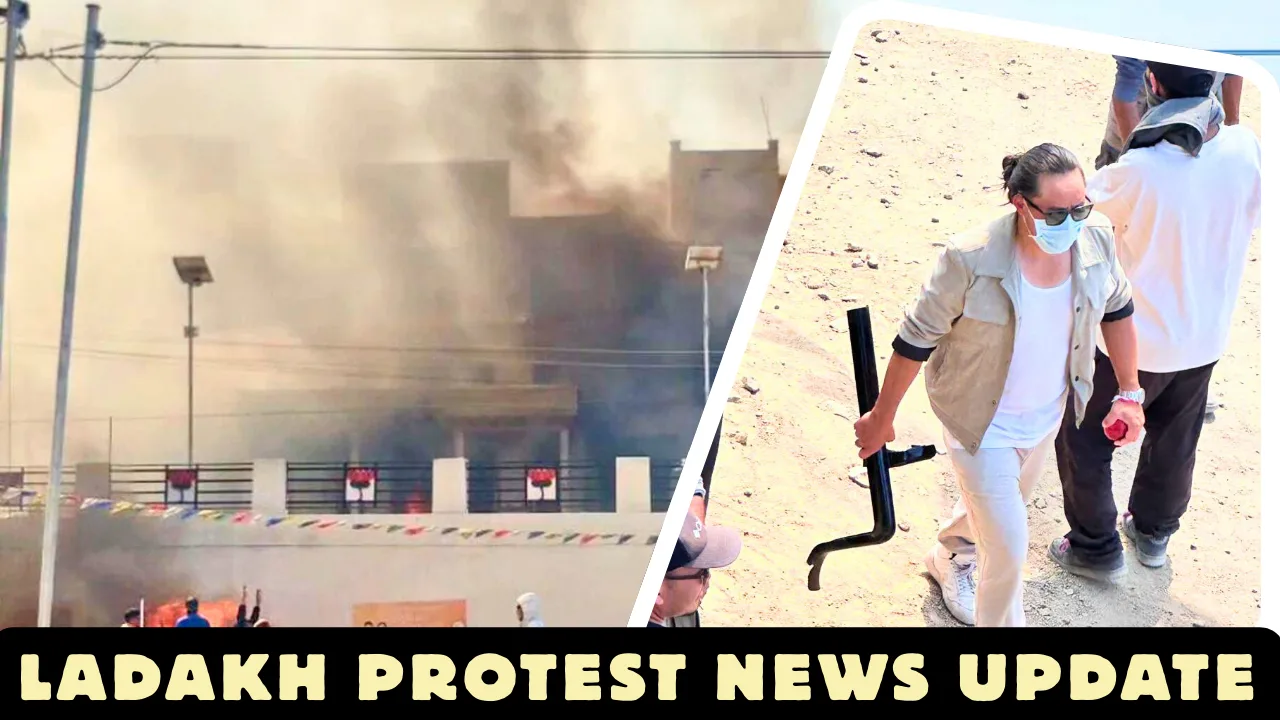Ladakh Gen Z Protests: Leh, the administrative heart of Ladakh, witnessed its deadliest unrest on September 24, 2025, when protests demanding statehood spiraled into violence. Once marked by peaceful hunger strikes and marches, the movement exploded into street clashes that left four people dead and over 70 injured. Police vans and the local BJP office were torched, teargas filled the air, and curfew gripped the cold desert town.
Activist Sonam Wangchuk, the face of the agitation, described it as a “Gen Z revolution,” pointing to the frustration of young Ladakhis who feel cut off from opportunities and betrayed by broken promises.
Why Are Ladakhis Protesting?
When Article 370 was abrogated in 2019, Ladakh was carved out as a separate Union Territory. Unlike Jammu and Kashmir, however, Ladakh was left without an assembly or elected government.
At first, many including Wangchuk welcomed the move, expecting more autonomy. But soon, discontent rose as residents realized they had no legislative voice. Instead, all decisions were controlled by the Lieutenant Governor’s office in Delhi.
Key demands include:
- Statehood for Ladakh
- Sixth Schedule protections for tribal and ecological safeguards
- Greater job opportunities and land rights for locals
- Checks on large-scale projects threatening the fragile Himalayan ecosystem
The Spark on September 24
- The trigger was the deteriorating health of hunger strikers. Fifteen protesters had to be hospitalized, fueling anger against what locals saw as government inaction.
- The Leh Apex Body (LAB) youth wing called for a shutdown. By late morning, crowds turned restive. According to the Ministry of Home Affairs (MHA), protesters left the hunger strike venue, attacked political offices, set vehicles on fire, and clashed with police.
- Security forces fired in self-defense, resulting in casualties. By 4 PM, curfew was imposed and Leh fell silent under a blanket of restrictions.
The Statehood Question: Why It Matters
Without its own assembly, Ladakh remains under direct central rule. Local leaders argue this has:
- Reduced self-governance
- Weakened land and job protections once enjoyed under J&K
- Ignored ecological sensitivities, with massive solar and infrastructure projects planned without local input
As a result, Leh’s Buddhist-majority Apex Body and Kargil’s Muslim-majority Democratic Alliance once rivals united under a single platform. This rare alliance reflects the depth of local frustration.
Who Is Leading the Protest?
The face of the movement is Sonam Wangchuk, a mechanical engineer turned climate activist and Ramon Magsaysay Award winner. Popularly known as the inspiration behind Aamir Khan’s character “Phunsukh Wangdu” in 3 Idiots, Wangchuk began a hunger strike on September 10.
Also Read: Nepal Gen Z Protest 2025: Army Takes Control of Kathmandu Airport Amidst Crisis
When fellow protesters’ health collapsed, the youth erupted. Wangchuk later said:
“For five years we have followed peaceful Gandhian methods. What happened today was unexpected, out of the blue, very organic. It was the youth’s anger spilling over.”
Centre vs Wangchuk: The War of Words
The Union government placed the blame squarely on Wangchuk, accusing him of “misleading people with Arab Spring references and Gen Z slogans.” The MHA said his speeches directly triggered the mob violence.
Wangchuk countered, calling it the BJP’s U-turns since 2020 and “five years of joblessness” that drove young Ladakhis to desperation.
Political Fallout: BJP vs Congress
The clashes quickly turned political. BJP IT cell head Amit Malviya accused Congress councillor Phuntsog Stanzin Tsepag of leading the mob and linked Rahul Gandhi’s speeches on “Gen Z saving democracy” to the unrest.
Congress dismissed the charges, with Wangchuk himself noting:
“I know Congress. They are not so competent that one leader could bring out 5,000 people. This was the people’s anger.”
Leaders React: From J&K to Ladakh L-G
- Omar Abdullah, J&K Chief Minister, said Ladakhis felt betrayed because they weren’t even promised statehood in 2019.
- Kavinder Gupta, Ladakh’s Lieutenant Governor, blamed “a conspiracy” and said protesters were responsible for the deaths.
What Lies Ahead for Ladakh
The government has announced that the High-Powered Committee will meet Ladakh leaders on October 6, with more meetings scheduled on September 25 and 26.
While calm has returned since the curfew, Ladakh’s core demands statehood, safeguards, and jobs remain unresolved. The next few weeks will determine whether dialogue can bridge the trust deficit between Leh’s restless youth and New Delhi.
A Defining Moment for Ladakh’s Future
The September 24 clashes have marked a turning point. For years, Ladakh’s youth embraced peaceful marches and hunger strikes. But their frustration with central delays, joblessness, and ecological fears has now erupted in flames on the streets of Leh.
Whether the Union government acknowledges these voices or continues to dismiss them as “provoked” will shape Ladakh’s path. For locals, this is no longer just about statehood, it is about identity, survival, and the right to decide their own future in the high Himalayas.
Spiritual Perspective: Leadership, Justice, and the Path Shown by Saint Rampal Ji Maharaj Ji
In times of unrest and political conflict, spiritual wisdom often provides the deepest clarity. As Tatvdarshi Saint Rampal Ji Maharaj Ji explains in his discourses, a true ruler must act with the fear of God in his heart, ensuring justice for the people and fairness in every decision. Without this divine accountability, governance often strays into broken promises and public anger.
Sant Rampal Ji Maharaj Ji teaches that through true satsang (spiritual knowledge), one learns to distinguish right from wrong, understand the duty of leaders, and recognize the identity of the Supreme God Kabir Sahib Ji. Where worldly systems and politics fail, the eternal spiritual path offers real peace and salvation.
FAQs on Ladakh Gen Z Protests and Statehood Demand
1. Why did protests erupt in Ladakh on September 24, 2025?
The protests turned violent after hunger strikers’ health deteriorated and frustration grew over the Centre delaying talks on statehood. Youths clashed with police, set fire to vehicles and offices, leaving four dead and dozens injured.
2. What are the main demands of Ladakh’s protesters?
Protesters are seeking full statehood for Ladakh, constitutional safeguards under the Sixth Schedule, greater job opportunities for locals, land rights protection, and eco-sensitive policies to safeguard the fragile Himalayan environment.
3. Who is Sonam Wangchuk and what role is he playing in the protests?
Sonam Wangchuk is a Ladakhi climate activist, engineer, and Ramon Magsaysay Award winner. He spearheaded the statehood movement with a hunger strike. The government accused him of inciting violence, but he insists the unrest was an organic outburst of the youth.
4. How has the Union government responded to the protests?
The Ministry of Home Affairs blamed Wangchuk’s “provocative” speeches for inciting violence. The Centre has scheduled a High-Powered Committee meeting with Ladakh leaders on October 6, with preliminary meetings on September 25–26.
5. How are local and national political leaders reacting?
While Ladakh’s Lieutenant Governor blamed protesters for the deaths, J&K Chief Minister Omar Abdullah said Ladakhis feel betrayed. The BJP accused Congress of fuelling the unrest, but Congress dismissed the claims, calling the protests a result of genuine public anger.

















